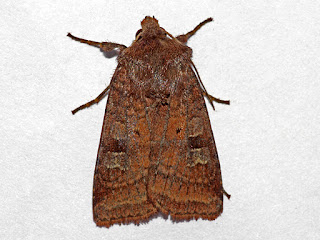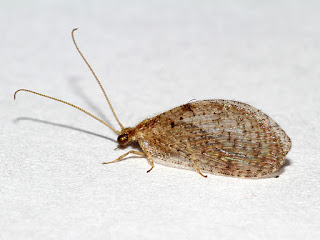There haven't been nearly so many Brown-tail nests here as I've seen in the past couple of years but in one of their best spots I did find another furry caterpillar. I believe this one is a Garden Tiger.
Garden Tiger, Burnham Overy, 28th May
There were lots of small micros in the dunes, mostly the same species - I counted about 90 Plain Fanners Glyphipterix fuscoviridella. There must have been thousands there. Among them was this Beautiful Groundling Caryocolum marmorea.
Beautiful Groundling Caryocolum marmorea, Burnham Overy, 28th May
Also Hook-streaked Grass-Veneer Crambus lathoniellus and 5 Cinnabars, and some Swollen-thighed Beetles. I think these are a male (with the swollen thighs) and a female (without).
Swollen-thighed Beetles Oedemera nobilis, Burnham Overy, 28th May
Another beetle found crawling across the dunes was this one. When I first published this I put it down tentatively as Silpha tristis, but I now think the long head indicates that it's Silpha atrata - still a new one for me.
Silpha atrata, Burnham Overy, 28th May
Butterflies put on a good show too, with at least 6 Small Coppers, at least 6 Brown Arguses, Common Blues, Peacocks, Small Heaths and Wall Browns.
Brown Argus, Burnham Overy, 28th May
My first non-Damsel Dragonfly of the year (about time too) was this Four-spotted Chaser in the dunes.
Four-spotted Chaser, Burnham Overy, 28th May
There were a few Hoverflies too, a couple of which I retained for identification. It seems that I can't get beyond genus for one of them even with the specimen, but Chryostoxum cautum was new for me.
Chrysotoxum cautum, Burnham Overy, 28th May
Sphaerophoria sp., Burnham Overy, 28th May
My attempts at Snail identification got me a new species, Wrinkled Snail Candidula intersecta. Apparently it also goes by the name Wrinkled Dune Snail which seems an appropriate name here but presumably not across the whole of its range that includes, for example, central England.
Wrinkled Snail Candidula intersecta, Burnham Overy, 28th May
I see a lot of these snail shells in the dunes but hadn't identified them until now. Now I just need to find one that's still got a snail inside it...
empty Striped Snail Cernuella virgata, Burnham Overy, 28th May
I bumped into Andy Bloomfield during the morning and he kindly showed me a few spiders. He's a bit into spiders and was excited to find a rare one known only from 12 other sites on the saltmarsh this morning. That was after we'd parted though, so I didn't see that, but here are the ones he showed me. All of them were new species for me.
Pin-stripe Wolf Spider Pardosa monticola, Burnham Overy, 28th May
Alopecosa barbipes, Burnham Overy, 28th May
Dune Wolf Spider Xerolycosa miniata, Burnham Overy, 28th May
Arctosa perita, Burnham Overy, 28th May - a shame I didn't focus correctly on this one as it was the coolest of the lot!
Andy also showed me something I had wanted to see for ages. I heard about Ant-lions turning up on the Suffolk coast a few years ago, the first time they'd been recorded in the UK. Some time later I heard they were at Holkham too but I had never found out where. Andy found some of their larval pits and explained how the larvae sit buried in the sand at the bottom of their pit with their pincers pointing up. When an ant falls into the pit they can't get out easily and so they end up at the bottom and fall prey to the Ant-lion. There were loads of the pits there - quite easy to find once you know what to look for - and we had a quick look at one of the larvae before returning it to the sand. Check out those pincers!
Ant-lion Euroleon nostras larva, Burnham Overy, 28th May
Now I'm looking forward to finding the adult Ant-lions, if I can. Apparently August afternoons are best.





























































